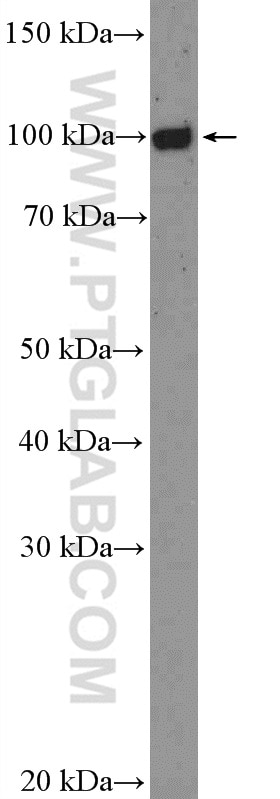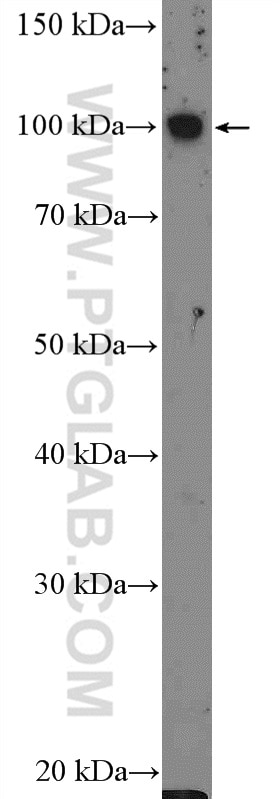FCRL5 Polyklonaler Antikörper
FCRL5 Polyklonal Antikörper für WB,ELISA
Wirt / Isotyp
Kaninchen / IgG
Getestete Reaktivität
human
Anwendung
WB,ELISA
Konjugation
Unkonjugiert
Kat-Nr. : 26503-1-AP
Synonyme
Galerie der Validierungsdaten
Geprüfte Anwendungen
| Erfolgreiche Detektion in WB | Daudi cells, Raji-Zellen |
Empfohlene Verdünnung
| Anwendung | Verdünnung |
|---|---|
| Western Blot (WB) | WB : 1:500-1:1000 |
| It is recommended that this reagent should be titrated in each testing system to obtain optimal results. | |
| Sample-dependent, check data in validation data gallery | |
Produktinformation
26503-1-AP bindet in WB,ELISA FCRL5 und zeigt Reaktivität mit human
| Getestete Reaktivität | human |
| Wirt / Isotyp | Kaninchen / IgG |
| Klonalität | Polyklonal |
| Typ | Antikörper |
| Immunogen | FCRL5 fusion protein Ag24351 |
| Vollständiger Name | Fc receptor-like 5 |
| Berechnetes Molekulargewicht | 977 aa, 106 kDa |
| Beobachtetes Molekulargewicht | 100 kDa |
| GenBank-Zugangsnummer | BC101067 |
| Gene symbol | FCRL5 |
| Gene ID (NCBI) | 83416 |
| Konjugation | Unkonjugiert |
| Form | Liquid |
| Reinigungsmethode | Antigen-Affinitätsreinigung |
| Lagerungspuffer | PBS mit 0.02% Natriumazid und 50% Glycerin pH 7.3. |
| Lagerungsbedingungen | Bei -20°C lagern. Nach dem Versand ein Jahr lang stabil Aliquotieren ist bei -20oC Lagerung nicht notwendig. 20ul Größen enthalten 0,1% BSA. |
Hintergrundinformationen
FCRL5, also known as CD307 or IRTA2, is a surface protein expressed selectively on B cells and plasma cells (PMID: 11290337). This protein has both an immunoreceptor tyrosine-based activation motif (ITAM)-like sequence and two consensus immunoreceptor tyrosine-based inhibitory motifs (ITIM) in its cytoplasmic region (PMID: 17522256). FCRL5 is implicated in B cell development and lymphomagenesis (PMID: 11290337; 11453668). It may have an immunoregulatory role in marginal zone B-cells.
Protokolle
| Produktspezifische Protokolle | |
|---|---|
| WB protocol for FCRL5 antibody 26503-1-AP | Protokoll herunterladen |
| Standard-Protokolle | |
|---|---|
| Klicken Sie hier, um unsere Standardprotokolle anzuzeigen |



